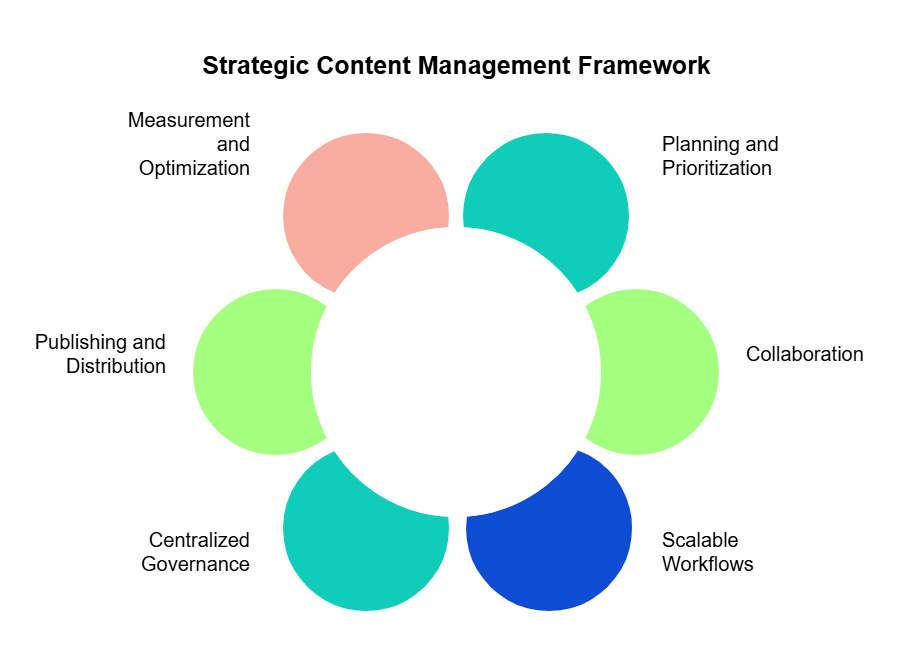We’ve all seen it: content from a brand or creator starts to decline just as their content marketing operation grows. Deadlines get tighter, teams multiply, and quality slips through the cracks.
Off-brand messaging, inaccessible formats, and underperforming assets often creep in when content production scales without structure.
When this happens, many teams assume the solution is to publish more. But more content only compounds the problem — it creates duplication, inconsistency, and wasted effort.
The real solution is stronger content management. A structured strategy gives your marketing team the workflows, tools, and guardrails to scale without losing quality.
Why content quality breaks down at scale
As you publish more digital content, cracks can start to show. Teams operate in silos, often with the SEO team running one strategy, brand marketing running another, and no one’s quite sure who owns what.
Creating standards, guidelines, processes, and workflows for content marketing is not the sexiest job. But setting standards is the only way to know if you can improve anything (with AI or anything else).
Communication issues remain a top non-creation challenge, with 61% of enterprise marketers citing siloes across the organization.
Organizations investing in modern content services report significantly fewer governance challenges—34% vs. 48% among less mature teams.
Enterprise content governance operationalizes strategy, turning goals and policies into systems, workflows, and performance metrics that scale.
Content governance is your website’s “rules of the road”—a sustainable system that ensures content is relevant, usable, effective, and aligned with strategy across complex organizations.
Only half (49%) of marketers surveyed feel their organization measures content performance accurately—the top challenge cited is integrating and correlating data across multiple platforms.
Tools like Siteimprove Content Behavior & Analytics can help close that loop by connecting performance insights directly to your content workflows, so you can quickly identify what’s working and what isn’t.
What is strategic content management?
Strategic content management is about controlling the full content lifecycle. It brings structure to every part of the process, from planning and creation to governance, performance tracking, and optimization.
Content management gives everyone clarity on what you’re making, why you’re making it, and whether it’s delivering results. Instead of treating content as a series of one-off assets, it treats it like a system that supports your business goals and improves over time.
In short, it helps you answer the questions every marketer should be asking: What should we make? Why does it matter? And is it working?
Key pillars of strategic content management

Building a strategic content system requires structure, alignment, and the right tools. These four pillars help enterprise teams manage content at scale without sacrificing quality.
Planning and prioritization: This is the foundation of your content strategy. It ensures every piece of content is tied to a clear goal. Planning also includes prioritizing what gets created first based on impact and resources.
Collaboration: This refers to how different teams (content, SEO, brand, design, legal, digital marketing, etc.) work together. It includes assigning clear roles, building shared timelines, and setting up approval workflows.
Scalable workflows: Workflows are the repeatable processes that take content from idea to publication. They grow with your team and your output. They reduce bottlenecks, minimize work, and keep quality high.
Centralized governance: This aligns your assets to your brand standards. It includes voice and tone guidelines, accessibility requirements, and SEO practices.
Publishing and distribution: This is when, where, and how your content is delivered. It includes managing a content calendar, aligning with campaign timelines, and pushing content to the right channels.
Measurement and optimization: This pillar connects content performance metrics back to strategy. It includes regular audits, reporting, and testing to refine content and improve results over time.
When these parts work together, your teams move faster, produce better content, and avoid duplicate or conflicting work.
That said, while the core framework stays the same, there may be some variations across industries. You may have to modify your content program based on your specific needs.
Tailoring content management strategies for different types of content
Not all content is created or managed the same way. Your content management strategy should adapt to the format without compromising quality, brand voice, or performance.
- Articles and blog posts need regular updates and SEO optimization.
- Video content requires metadata, transcripts, and accessible playback features.
- Social media content moves fast and needs consistent voice and visual branding.
- Infographics and visuals need alt text and color contrast reviews.
- PDFs, slide decks, and downloadable assets must meet accessibility and compliance standards.
The top content management strategies
While you can (and should) build your content management strategy in whatever way suits your goals, it helps to understand the different mainstream strategies.
1. Centralized strategy
In this system, all digital content decisions, processes, and approvals flow through a central team, usually marketing or content operations. This team sets the standards for brand voice, SEO, accessibility, publishing cadence, and performance tracking. Other departments may contribute, but the centralized team owns execution and content governance.
This content marketing strategy is the most consistent. It's easier to enforce standards and apply scalable processes (like templates and editorial checklists) when there’s one person at the top.
However, this system can create bottlenecks, slow down production, and limit the autonomy of sub-teams that need to move quickly.
It certainly isn’t fast.
2. Decentralized strategy
In this paradigm, each department or business unit creates and manages its own content. There may be shared brand guidelines, but execution is handled independently.
This approach allows your marketing team to move fast and tailor content development to different audiences. But without strong coordination, it often leads to inconsistent messaging, duplicated work, and content quality that varies widely from one team to another.
3. Federated (hybrid) strategy
This is a blend of centralized governance and decentralized execution. A core content team sets strategy, standards, and tooling, while individual teams create and manage content within those guardrails. It’s often supported by shared templates, training, and automated QA tools.
Federated strategies are both scalable and flexible. They offer the control needed to maintain brand awareness and integrity, while still giving on-the-ground content creators room to adapt.
The challenge here lies in maintaining alignment and oversight. If those guardrails aren’t enforced, standards can erode over time.
4. Agile content strategy
Inspired by agile software development, this strategy focuses on rapid iterations, short production cycles, cross-functional squads, and lots of feedback.
The agile model is fast and responsive. It’s best for performance-driven teams that need to learn fast and iterate often, like social media marketing teams.
On the flip side, this content model can sacrifice long-term consistency and requires tight coordination across teams to stay on track with brand and compliance standards.
| Feature | Centralized | Decentralized | Federated (Hybrid) | Agile |
|---|---|---|---|---|
| Decision-Making | Owned by a central team | Owned by individual departments | Shared between central and local teams | Shared by cross-functional squads |
| Speed of Execution | Slower, due to approvals and bottlenecks | Fast, autonomous teams | Balanced, depending on guardrails | Very fast, iterative cycles |
| Consistency of Brand Voice | High, centrally enforced | Low, varies by team | Moderate to high, with central oversight | Variable, depends on team coordination |
| Governance and Compliance | Strong control, high compliance | Weak control, high risk | Moderate to strong, guided by central standards | Inconsistent unless embedded into sprints |
| Scalability | Challenging as volume grows | Easy to scale but hard to control | Scalable with systems in place | Scalable with team training and sprint discipline |
| Content Quality | Consistent, due to oversight and QA | Inconsistent, varies by team capability | Strong if workflows and tools are standardized | High-performing but may lack polish or long-term view |
| Team Autonomy | Low, centralized approvals required | High, teams operate independently | Medium, teams operate within structured guardrails | High, teams manage their own backlog and output |
| Best Fit For | Regulated industries, tight brand control | Large orgs with varied markets or products | Enterprises needing balance of control and flexibility | Performance-driven teams, experimental content |
Tools that support strategic content management
A strategic approach requires a tech stack that supports governance, collaboration, and performance tracking. But it can’t slow you down!
Content management systems (CMS) with governance features
Modern CMS platforms do more than publish pages. The best ones support custom templates that enforce brand and SEO standards, role-based permissions to control who can edit, approve, or publish, and version control and audit trails for accountability.
Look for a content management system that integrates with your analytics, QA, and accessibility platforms so your content creation is easier to govern and scale.
Digital asset management (DAM) tools
DAM platforms help you organize and reuse brand-approved images, videos, documents, and design elements. This asset library forces everyone to use on-brand, high-quality assets. It also helps you manage IP licenses and collaborate with external creators and partners.
Accessibility and QA platforms
Even the best teams miss things. Automated quality assurance tools scan your digital content for issues before they become problems.
Platforms like Siteimprove Accessibility help you identify accessibility violations and fix them quickly, flag broken links, misspellings, and SEO gaps, and monitor site performance and content compliance over time.
This is a critical layer of quality control that you can’t ignore if you publish content across multiple channels at a high pace.
Workflow and collaboration tools
You undoubtedly use a collaboration tool in your day-to-day, but they work well for content programs as well. Tools like Asana, Airtable, Trello, or Monday help you track progress from brief to publish, assign clear roles and deadlines, and centralize communication to avoid silos.
Getting started with strategic content management
You don’t need to overhaul everything overnight. Improving your content management strategy starts with small, deliberate moves that build a quality-driven system.
-
Step 1: Audit your current content creation workflows
Map how content moves from idea → draft → review → publish → performance review. Note inefficiencies, bottlenecks, and duplicated work.
-
Step 2: Identify quality gaps and content silos
Check for accessibility issues, inconsistent voice, and underperforming pages. Find siloed teams producing content without shared strategy.
-
Step 3: Define shared standards and documentation
Create enforceable brand guidelines for voice, tone, accessibility, SEO, and formatting. Keep them easy to find and integrate into workflows.
-
Step 4: Roll out cross-team workflows with clear ownership
Assign roles across content, SEO, design, legal, and marketing. Set review gates, approval paths, and feedback loops.
-
Step 5: Choose tools that support your process
Select CMS, DAM, QA, and collaboration tools that integrate well and automate governance where possible.
-
Step 6: Set up performance tracking and audits
Build dashboards for engagement, SEO, accessibility, and time-to-publish. Schedule regular audits to catch issues early. Siteimprove’s reporting tools make it easy to track these KPIs in one place and surface issues that might otherwise go unnoticed.
-
Step 7: Train your teams
Offer training and onboarding so creators and stakeholders understand the “why,” the standards, and how to work in the new system.
What success looks like
- Fewer reworks and publishing delays
- Consistent voice and accessibility compliance
- Clear ownership and measurable performance improvement
Better content with strong management
Content quality can slip little by little as teams scale, priorities shift, and workflows get messy. Strategic content management gives you the structure to catch those issues before they spread. With a proactive approach, your content can stay consistent and continue to serve your goals.

